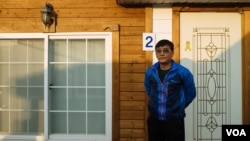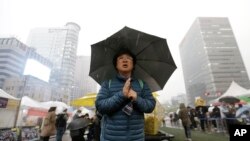This week, South Korea marks the one-year anniversary of one of the country’s deadliest maritime accidents. Hundreds of passengers onboard the Sewol ferry died last year after the ship capsized in waters off the peninsula’s south coast.
An investigation found the boat was overloaded and had undergone modifications that made it unstable. The ferry still rests on the ocean’s floor, but the relatives of those still missing now want it raised.
The concrete pier at Paengmok port extends a few hundred meters into the sea. It is now covered with painted tiles, banners and yellow ribbons - a tribute to the victims of the Sewol ferry disaster.
Missing bodies
It was here, a year ago on April 16 that rescuers brought back to land the 172 survivors of the accident and over the following months the nearly 300-bodies of those who drowned when the ship capsized and sank.
In November the recovery effort was called off, even though nine bodies remain missing. Some of the victims' families believe their bodies are still trapped inside the wreck.
And some of those relatives now stay in small cabins adjacent to the port.
One of them is 60-year-old Kwon Oh-bok, whose brother and nephew have not been found. He said he feels frustrated.
The government is playing a game with us, he said. Last year they said they would lift the ship, he continued, and now they say they need to review the plan. He says this ordeal keeps dragging on.
Seeking closure
Raising the ferry and recovering those missing will help bring closure to the families, said 46-year-old Lee Geum-hee. Her teenage daughter was one of the many high school students onboard the Sewol that day and still has not been found.
We watched our children die live on TV and here at the port, she said. She added that many questions still are left unanswered.
And now many of the Sewol families and their supporters are again calling on the South Korean government to provide answers about the accident - from the street.
Some of the victim’s relatives, who have shaved their heads in protest, say last year’s investigation into the accident was flawed and a new probe is not independent enough.
Protestor Chun Myeong-seon, who lost his son on the Sewol, said it is an insult for the government to offer compensation money while those nine passengers remain missing.
Under the plan, families of each deceased high school student would receive about $380,000. Families of other passengers would receive more based on factors like loss of income.
Remaining issues
Some observers say these protests make it hard for the country to move on.
Yang Seung-ham, a sociology professor at Seoul’s Yonsei University, also said the government’s superficial reforms following the accident, like disbanding the coast guard, most likely will not prevent another disaster from happening.
He noted the South Korean public is not taking safety more seriously now either.
“After the accident, we need to change the safety culture, but the people, they easily forget about the tragedy,” said Yang.
Back in his cabin at the Jindo port, Kwon Oh-bok said he is not going anywhere for now.
He said he will not leave until there is a solid plan to recover the missing bodies.
Kwon added that he hopes he can leave the port soon. He said he is almost broke and has been drinking too much alcohol to help cope with his pain.







